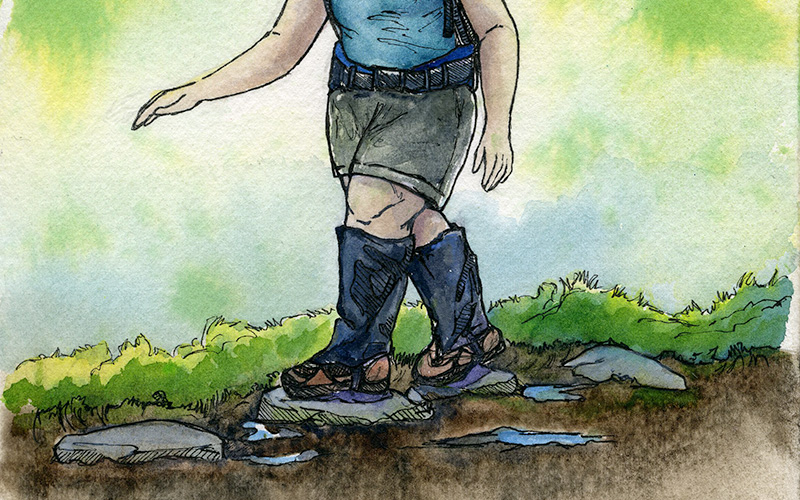Mud season hiking etiquette calls for staying in the middle of the trail and stepping on rocks, when possible.
Mud season can be a challenge for hikers and trail maintainers alike. So if you want to hike in the spring, knowing how to safely enjoy soggy trails without destroying them is an essential outdoor skill.
Wet Trails are Fragile
“More and more people are hiking year-round, and while it is wonderful to have people enjoying the trails, [hikers] are also having an impact,” says Alex DeLucia, the manager of AMC’s trails volunteers and Leave No Trace programs.
According to DeLucia, the saturated surfaces following spring snowmelt are a trail maintainer’s nightmare. Each hiker’s step churns up mud and sets the stage for serious erosion. “Some maintainers would like to see most trails closed in mud season, but we prefer to ask people to hike responsibly in all seasons,” he says.
Early spring hiking etiquette requires always walking in the center of the treadway. Sticking to rocks wherever possible will preserve both the trail and your footwear, and stepping into water and mud when necessary will minimize trail damage. Although you may be tempted to walk along the sides of the trail to keep your feet dry, doing so loosens soil and makes the trail more susceptible to erosion.
Mud and Ice are Slippery
A muddy trail forces you to slow down and pay attention to each step. Lug-soled hiking boots caked with mud don’t provide much traction, and a slip could be embarrassing or, worse, lead to injury. Expect to hike slower than normal and plan a shorter hike than you would when trails are dry. Once you do hit the trail, proceed with caution.
Trekking poles are helpful on wet trails, both to keep you upright and to probe the depths of what you’re stepping into. But, DeLucia cautions, poles loosen soil and accelerate erosion, so minimize your impact by fitting them with rubber tips.
Trails at high altitudes or in shaded areas can pose an additional challenge, with rails of winter ice lingering down the center of the trail. Traction aids, such as MICROspikes, are essential in these conditions.
Choose your Hike Wisely
A trail you can hike in soggy spring conditions without causing irreparable damag is a rare and precious find. This is not the season for exploring lowlands or wetlands, nor is it the time to hike steep basins, such as the Great Gulf or Wild River wilderness areas in the White Mountain National Forest (WMNF), where crossing runoff-swollen streams is dangerous.
In the mountains, the best spring trails are well-constructed, well-traveled routes that have been hardened for heavy use; the lower half of the Tuckerman Ravine Trail in the WMNF is a perfect example. Or follow a south-facing, rocky ridgeline trail; Old Toll Road to White Cross on Mount Monadnock in southern New Hampshire is a personal favorite. You’ll still encounter mud and ice, just not as much.
If you want an absolutely clear conscience, hike a sandy coastal route, such as the Great Island Trail in Wellfleet, Mass., or a road that’s closed in the spring, such as those on Mount Greylock in western Massachusetts, or Pack Monadnock or Cathedral Ledge in New Hampshire. Mud season is also an opportune time to explore old railbeds, like the Presidential Rail Trail between Gorham and Whitefield, N.H., which were built with heavier traffic in mind.
Keep Feet Dry and Comfy
Choosing springtime footwear is a conundrum: 6-inch-high water-proof boots don’t suffice when you step in an 8-inch-deep puddle, but knee-high rubber boots don’t offer adequate cushion or support.
Wearing gaiters will help keep your feet dry in the cold spring mud. You also could invest in a pair of knee-high waterproof socks and rubber-soled wading or portage boots—popular with anglers and paddlers. Your feet stay warm, you get the traction you need for safety, and you can comfortably walk in the center of the trail to reduce your impact.
LEARN MORE
Mud season also means high water levels. Learn how to cross moving water safely here.

